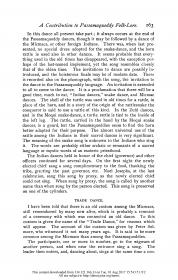Esunomawotultine
The trading dance is the second song on wax cylinder #17 sung by Peter Selmore and recorded by Jesse Walter Fewkes in Calais Maine, March, 16 1890.
In March 1890, Walter Jesse Fewkes traveled to Calais, Maine to work with the Passamaquoddy Tribe to test out the new phonograph technology. Over three days, Fewkes made recordings on 35 wax cylinders. 31 of these cylinders remain. He recorded songs, vocabulary, numbers and important Passamaquoddy cultural narratives. Peter Selmore, Noel Josephs and Perle Lacoot have been identified as three key individuals who Fewkes worked the most closely with. These are the first sound recordings ever made featuring Native American voices. Fewkes made contact with members of the Passamaquoddy Tribe through his benefactor Mary Hemenway from Boston who had a friendship with Mrs Louisa Brown in Calais, Maine.
Esunomawotultine is the Passamaquoddy name for song 2 on cylinder 17. Esunomawotultine means lets trade. It was sung on the cylinder by Peter Selmore, who also provided the cultural narrative. This narrative is found in Fewkes’ Calais Field Notebook and was written up in the Journal of American Folklife 1890. The song and dance is common to Passamaquoddy, Maliseet, Mi’kmac and Penobscot communities. According to Nicholas Smith, the Wabanaki had at least three different types of trading dances. "The important gift-giving trait was an element in two of them. One was the trading dance of the ceremonial prelude to the actual trading at aht efur trading posts. I have called another the hunter's trading dance...The third was the misunderstood peddler dance, a dance song in which the Indian satarizes the peddler as a highly motivated businessman. They despise greedy traders. The Peddler was apparently ignorant of the importance of the gift-giving role in Indian culture." (Smith 1996) According to Smith, who interviewed Maliseet (Peter and Minnie Paul of NB) and Passamaquoddy (Sabattus Tomer of Peter Dana's Point) elders about the various trading dances, the peddler dance cannot be considered a trading dance song, but it added humor at social gatherings.
According to Fewkes documentation from Peter Selmore this is a song and dance to encourage exchange or trade: “The participants, one or more in number, go to the wigwam of another person and when near the entrance sings a song. The leader then enters, and dancing about, sings at the same time a continuation of the song he sang at the door of the hut. He then points out some object in the room that he wants to buy, and offers a price for it. The owner is obliged to sell the object pointed out, or to barter something of equal value.”
For this song and dance the women would wear traditional Passamaquoddy dress including pointed caps covered in beads, loose robe and leggings. The face of the leader was painted or daubed black with paint or powder and his hair would be tied up so that it stood up.
Wayne Newell adds that the person who is the leader for this song needed to have a terrific voice. The leader needed to be able to encourage participation, to help gain momentum and to get people to join in the dance and in the trading. The leader was usually male, but sometimes female.
There are many versions of this song. The Maliseets have a version and so do the Mi’kmacs. Grace Davis (Passamaquoddy) continues to sing a version of this song. Wayne Newell is teaching it to other members of the Passamaquoddy community.
Engineer notes: Some damage at the beginning of the cylinder. There is a segment at 00:15 that exceeds 0 dB. The recording was made in reverse and corrected with Pyramix.; FCP notes: Announcements at the beginning and at 1:22 identify the songs.
Related Fewkes' fieldnotes are located at the National Anthropological Archives (ms. 4408:9) p. 22-23, 28.
Introductions in English, remainder in Passamaquoddy language.
Calais (Me.)






